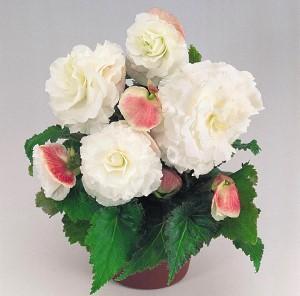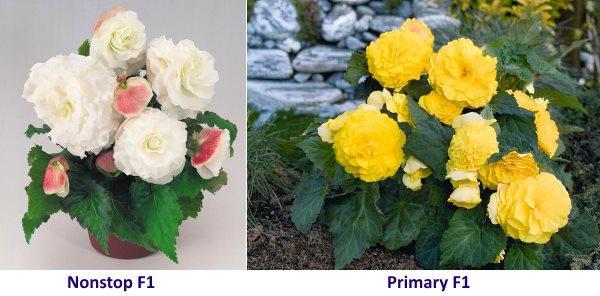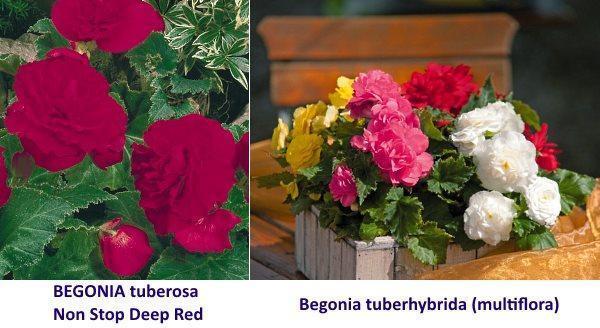How to grow tuberous begonia from seeds, tubers and cuttings at home - expert advice
 The huge assortment of varieties of tuberous begonias, photos of which can be seen on this page, is simply amazing. Amazingly beautiful bright decorative flowers can decorate any corner of the garden from early spring to mid-autumn. Starting from a simple form and ending with a terry inflorescence resembling a peony or a camellia, begonia will become the highlight of a balcony flower garden or street flower bed. And varying the color range from simple white to purple with edging on the petals will turn your home area into a multi-colored kaleidoscope.
The huge assortment of varieties of tuberous begonias, photos of which can be seen on this page, is simply amazing. Amazingly beautiful bright decorative flowers can decorate any corner of the garden from early spring to mid-autumn. Starting from a simple form and ending with a terry inflorescence resembling a peony or a camellia, begonia will become the highlight of a balcony flower garden or street flower bed. And varying the color range from simple white to purple with edging on the petals will turn your home area into a multi-colored kaleidoscope.
To achieve this effect, you must have enough varieties of this crop to plant. However, not everyone can afford to buy such a number of flowers. And no one can guarantee that the plant will not die after transplantation. Therefore, the way out of the situation will be to grow tuberous begonia from seeds at home, which will make it possible to make dreams come true and at the same time save part of the family budget.
Characteristics of tuberous begonia
It is not easy to grow tuberous begonia at home. Therefore, in order to get the maximum number of young plants and guarantee abundant flowering, you need to know all the intricacies of growing and caring for it. The decorative flower has several hybrid forms and belongs to perennial herbaceous tuberous plants with fleshy, succulent and branching stems.
Depending on the shape of the bush and the size of the flower, they are:
- large-flowered (7-20 cm);
- medium-flowered (up to 7 cm);
- small-flowered (multiflora);
- ampelous.
I would like to focus on the fact that each variety of tuberous begonia has a different attitude to light. So the large-flowered tuberous begonia, the photo of which is presented below, develops well and blooms profusely in partial shade. And as for small-flowered and ampelous forms, they prefer areas with sufficient lighting.
Almost all varieties of tuberous begonias are negatively affected by a decrease in temperature and weak frosts. Flowering also worsens during dry and hot weather, which greatly heats the soil and for this reason the root system of begonias stops developing.

Growing tuberous begonia from seeds at home
The seeds of begonia are very small, therefore, in order to improve germination and ease of planting, the producer covers each seed with a soluble shell. Planting tuberous begonias in the prepared substrate can be carried out in two ways:
- In the first case, they are sown directly into the ground, after which they are moistened with a growth stimulator.
- And in the second method, reproduction of tuberous begonias involves laying granular seeds on a layer of snow. After it melts, the granules will be in the moistened soil.
After planting, the seed containers are covered with transparent material to create optimal conditions for the seedlings.

When growing tuberous begonia from seeds on the windowsill of the house, it is very important to observe the temperature regime. Seedlings show good development at an air temperature of 22-24 ° C. It is also necessary to maintain soil moisture. Otherwise, the seed pellets may dry out and harden, preventing the sprout from hatching.
When a plant forms 1-2 true leaves, it is dived for the first time in a 2X2 container. Planting seedlings of tuberous begonia in a permanent place is carried out 5 weeks after the first pick.
Reproduction of tuberous begonias in various ways
Seed propagation of tuberous begonia is not the only way to grow a beautiful flower. The bush of the plant can also be obtained using the tuber, its division and leaf cuttings.
Growing begonias from a tuber. After the begonia has faded, it must be dug out with a large earthen lump and, after it has dried, placed in a container with sand and peat for winter storage. During the entire period, so that the tuber is well preserved, the container with the substrate is occasionally watered. With the arrival of stable warm weather, when the threat of frost has passed, the tubers, cleared of the soil, can be planted in a permanent place.
Also tuberous begonias at home can be obtained by dividing an adult tuber. To do this, a successfully overwintered and healthy tuber is divided into several parts, the length of which should be no more than 5-8 cm. When it is fragmented, it is imperative to leave one bud on each part. Sprinkle the places of the cuts with crushed ash.

Plant the prepared parts of the tubers in an upright position in moistened soil in a pot, which is covered with a film (glass) on top and put in a bright place. After the plant is well rooted and several leaves appear on the shoot, the cover can be removed from the container and planted in a separate pot or soil. Care begonia tuberous at this stage will consist of timely watering and feeding with complex fertilizers.
Propagation by cuttings of tuberous begonia. For grafting, a cutting is selected that has at least two buds, and the adult leaves growing on it are cut in half. To root the plant, a substrate consisting of sand and peat (3: 1) is used. A hole is made in it, into which the prepared cutting is carefully placed. The container is covered with a bag or cut-off plastic bottle. During the rooting process, make sure that no condensation forms. After 2-4 weeks, the cuttings give roots.
Tuberous begonia care
Begonia require abundant watering during the growing season and moderate irrigation during flowering. Also, for good development and constant ejection of buds, the plant needs the introduction of organic minerals and fertilizers. From the beginning of the first frosts, the tuber of the plant is dug up and left for winter storage in a dark, dry and well-ventilated room, the temperature of which should not exceed 3-5ºC. In the month of May, pre-germinated tubers in a pot can be planted in the ground.